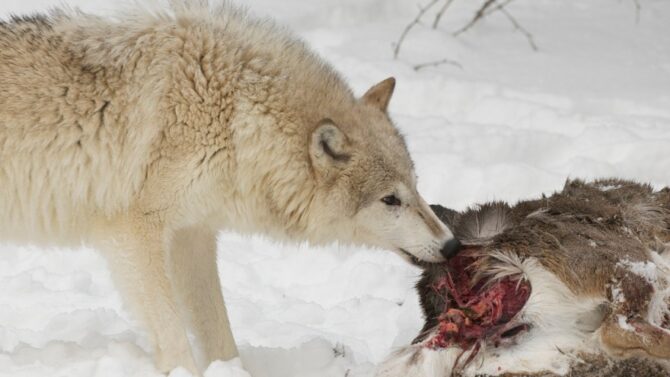The wolf is an animal that needs no introduction as it is known everywhere and still keeps expanding.
A wild canid, the wolf has been known to flourish in its ranges and habitats. A good reason for this could be that wolves are top predators.
That leads us to the central question we seek to answer about the wolf’s diet.
As apex predators, wolves are carnivores. They eat meat and prefer large hoofed animals, though they are not limited to that.
Examples of animals that wolves prey on are deer, elk, moose, and mountain goats. They have a large appetite, eating up to 20 pounds of meat in a meal.
We will take an in-depth look at the wolf diet and information that will help us understand their feeding habits.
What Do Wolves Eat?
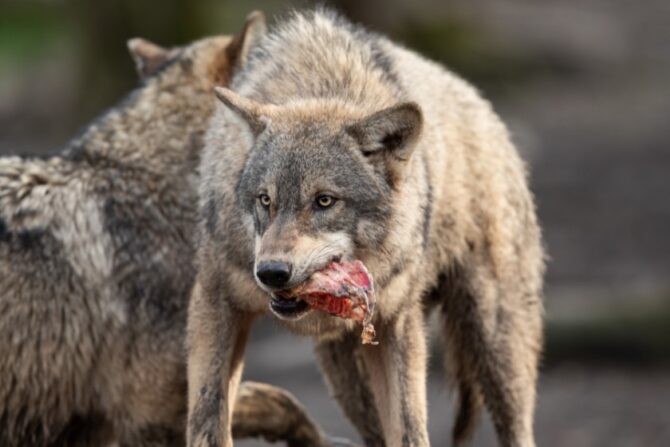
Wolves are carnivores, similar to many other canids (some possible exceptions include the domestic dog and the coyote).
Its preference happens to be hoofed mammals, and because they hunt in packs, they can take down a bigger creature like a moose.
They often target the weakest member to avoid being attacked in return.
Given their preference, wolves often hunt down red deer, moose, elk, caribou, mule deer, bison, and muskoxen.
Its choice often depends on the environment it finds itself. Wolves occur across the Eurasian region (Europe + Asia) and North America.
In Eurasia, it goes mainly after moose, deer, and boar. North American diet consists mainly of elk, moose, and caribou.
Wolves aren’t picky eaters, though. They might prefer hoofed mammals, but not at the exclusion of other prey. Mice, rabbits, and hares also add to its diet.
Then there’s the influence of climate, which we’ll look into next.
What Do Wolves Eat in Winter?
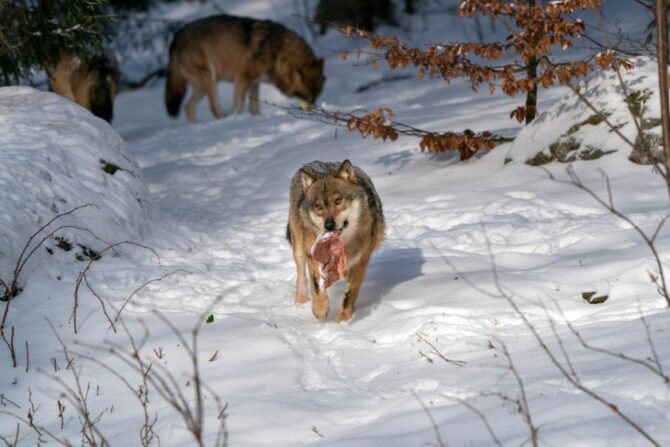
Winter isn’t the best season for many animals, wolves inclusive.
However, this doesn’t mean winter can’t be advantageous to wolves. Sometimes it is. This all depends on how heavy the snowfall is.
When the snowfall is heavy, deer become vulnerable and an easy target for wolves.
By contrast, when the snowfall is light, wolves find it difficult to locate another of their core prey, the whitetail hare.
Overall, winter isn’t ideal for wolves. They need more pounds than they can get in a cold climate, and they often have to go days and even weeks without eating.
Dive Deeper: Do Wolves Hibernate Or Migrate In Winter?
What Do Wolves Eat in Spring?
Springtime is better than winter for wolves because of the diversity of diets they have at their disposal.
The caribou, moose, and elk are all large mammals that appear during spring, giving the wolf many palatable options to choose from.
They also have beavers coming out during this season, giving more nutrients to our canids.
Also, wolves mate during the spring, which is why they eat a lot during this period.
They need to put on weight and prepare for reproduction, which is even more important for females.
During the spring, wolves eat what they may not usually consume during other seasons.
Examples are fish, snakes, insects, lizards, and earthworms. Wolves can also leave their usual carnivorous diet to feed on flowers, which we’ll look into in detail later.
What Do Wolves Eat in Summer?
Just as spring is the mating season for wolves, summer is the hunting season. Each season comes with its dietary requirement.
While during spring, the wolf has a lot of options, in summer, it tends to rely more on ungulates like deer.
Because summer is its hunting season (though not the only hunting season), wolves have to hunt when looking for food.
In a year, wolves kill close to 50,000 deer during the hunting season. No doubt, wolves are strong hunters.1
Wolf Species & Diet Requirements
There are different types of wolves, each with its dietary needs. We’ll look into these species in more detail.
Gray Wolf Diet

The gray wolf goes by the scientific name Canis lupus, and it is the most popular variety.
It comes with multiple subspecies, amongst which is the domestic dog.2
The gray wolf is also the biggest living canid in the world, which directly affects its dietary needs.
Gray wolves have big appetites, and they can eat up to 20 pounds in one sitting. Overall, they need at least four pounds a day to be in good condition.
Thus, gray wolves often go after huge prey like ungulates to get enough meals for the day.
Examples of targeted prey are elk, moose, and white-tailed deer. They can equally go after smaller animals when bigger ones may not be accessible.
However, big prey remains their preference, and they can travel long distances to find one.
This often puts them in conflict with humans, with casualties on both sides.
Gray wolves hunt well during winter due to the many vulnerable ungulates, and in summer, they also have access to small animals that can meet their dietary needs.
Eastern Wolf Diet
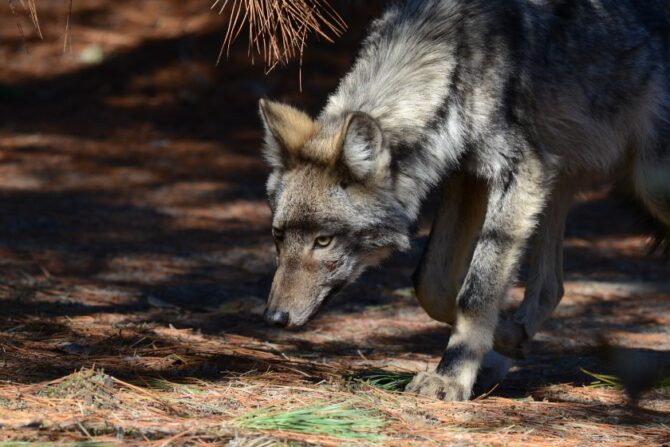
The eastern wolf is a lesser-known wolf variety. Once classified as a subspecies of the gray wolf, it has since been granted its autonomy.
This separation from the gray wolf is due to the eastern wolf sharing more ties with the coyote. It is a hybrid of the wolf and the coyote.
The eastern wolf has a low population, with only about 500 left. That said, we can deduce its diet and hunting style.
It moves in a pack similar to that of the gray wolf but can also hunt in solitary like its coyote relative. Its pack is usually smaller than that of the gray wolf.
The Eastern wolf’s diet includes moose, beavers, white-tailed deer, and muskrats.
Red Wolf Diet
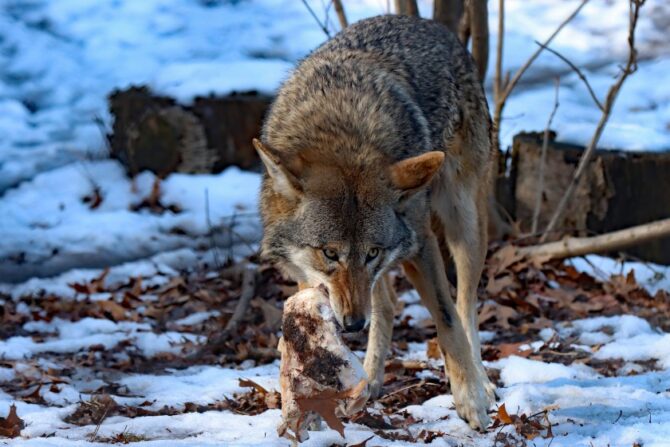
Red wolves are similar to coyotes both in size and color, but it is a species distinct from the coyote and even the gray wolf.
It is smaller than its wolf cousin, with the size impacting the diet and hunting style.
These canids hardly go after large prey as grey wolves do, mainly because they may be unable to take it down.
They’d rather hunt animals like raccoons, mice, rabbits, and other small mammals. The only ungulate the red wolf goes after is the white-tailed deer.
Maned Wolf Diet
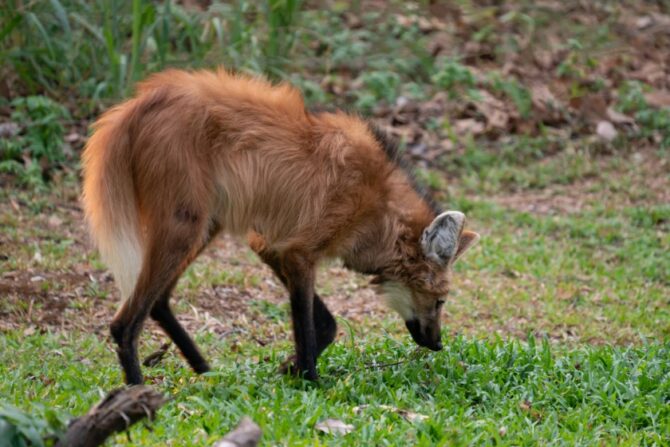
The maned wolf looks like a fox and is named after wolves, but in reality, it is neither a fox nor a wolf.
It is a different canid and the only species in the Chrysocyon genus. However, it is associated with wolves because of its name.
The maned wolf is an omnivore and can feed on plant matter for an extended period. Berries are one of its preferred fruits.
As for animal matter, the maned wolf feeds on insects and small mammals like rodents.
How Do Wolves Hunt For Food?
Wolves can hunt alone, even when faced with big animals like moose. However, they are more effective when they move as a pack.
The wolf pack usually consists of 4 or 5 wolves, but they may get up to 15.
Each pack has an alpha who gets privileges like being the first to eat out of prey.
Their mode of attack depends on the prey they’re going after. For animals like deer, wolves have to avoid getting injured by hooves.
They attack from behind and keep a safe distance from the hooves. With smaller animals, they need no precautions and attack directly.
Other members of the pack eat only after the alpha male (and its female) are done. They go for the meat and often avoid the bones.
Dive Deeper: Do Bears Eat Wolves? Or The Other Way Round?
Can Wolves Eat Fruits and Vegetables?
Wolves are carnivorous, with a diet dominated by meat. However, there are situations where they feed on grass.
They do this for the same reason dogs do when they’ve eaten something their stomach doesn’t agree with.
The grass has a purging effect that enables them to clear off whatever could be causing stomach issues.
Wolves are also known to enjoy some fruits, especially during spring when they have to eat more (as we’ve mentioned above).
Examples of these fruits are cowberries, pears, apples, and blueberries.
Dive Deeper: Can Wolves Climb Trees?
Wolf Feeding Habits and the Ecosystem
Wolves play many positive roles in the ecosystem, sometimes more than we know. This includes how their feeding habits help out.
When wolves hunt down ungulates, they often go after vulnerable ones like the sick and old.
This prevents the risk of overpopulation. This also applies to smaller prey like rodents. In a way, we need wolves to hunt.
These wild dogs‘ actions also have an impact on other predators. For example, they compete with coyotes, sometimes forcing the latter to find other habitats.
The reduced population of the grey wolf has helped with the increase of coyotes.
As scavengers, coyotes sometimes feed on the carcass left by wolves.
Artic wolves have also started preying on polar bear cubs, which might lead to competition between these two animals.
Wrap Up
Wolves are carnivorous, more than their relatives, the coyote. However, seasons can affect their dietary choices, and you may even find them feeding on fruits rather than just animals.
Each wolf type also has its preferences. In general, some examples of animals that they often prey on are ungulates and small mammals.
The effect of these animals on the ecosystem are numerous.
References & Notes
- Hunting & Feeding Behavior. International Wolf Center.
- Dog – Evolution and related canids. Britannica.
